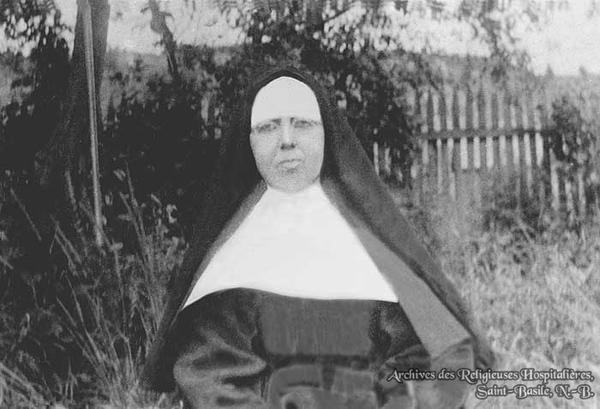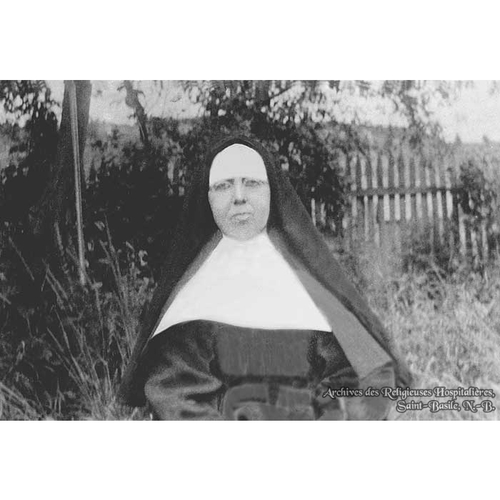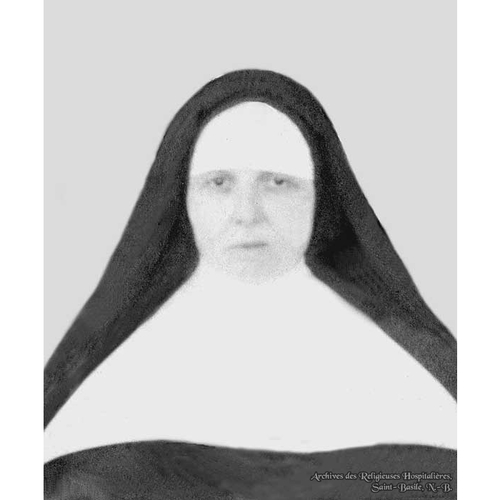
Source: Link
RANGER, MARIE-ALPHONSINE-EULALIE, dite Maillet, Religious Hospitaller of St Joseph, nurse, pharmacist, local superior, and educator; b. 10 Nov. 1846 in L’Acadie, Lower Canada, daughter of François Ranger and Geneviève Bourassa; d. 30 March 1934 in Saint-Basile (Edmundston), N.B., and was buried there 3 April.
Niece of the artist Napoléon Bourassa*, cousin of the future politician Henri Bourassa*, and daughter of a Patriote [see Pierre-Théophile Decoigne*], Marie-Alphonsine-Eulalie Ranger was born in the settlement of L’Acadie. She studied there with the Sisters of the Congregation of Notre-Dame and then entered the noviciate of the Religious Hospitallers of St Joseph of the Hôtel-Dieu in Montreal on 4 Aug. 1864. She made her vows in 1866 and took the name Sister Maillet in honour of Marie Maillet*, one of the founders of the Hôtel-Dieu in Montreal.
After practising as both a nurse and pharmacist in this institution, Sister Maillet joined a group of six Religious Hospitallers called to take charge of the convent of Saint-Basile in the region of Madawaska, N.B., and to open a hospital there. They were to replace the Sisters of Charity of Saint John [see Honoria Conway*], who as a result of the passage of the Common Schools Act in 1871 [see George Edwin King*] had been forced to abandon their work. On 11 Oct. 1873, at the age of 26, Sister Maillet arrived in Saint-Basile. The small convent, which also served as a school, orphanage, and hospital (which the sisters named Hôtel-Dieu St Joseph), was located in an old single-storey house. Although the official and canonical installation of the Religious Hospitallers, which was presided over by the bishop of Chatham, James Rogers*, took place on 10 November, the founding nuns had received their first patient on the 5th. The local population seemed to have misgivings about these women, whom they distrusted and feared would need their financial support. The nuns lacked everything, especially food and medicine. As the hospital pharmacist, Sister Maillet had to be creative to treat her patients. In her journal, the “Commencement de notre fondation,” she recounts that to care for the sick, “having no medicines, [she could] only apply oil of Our Lady of Mercy.” After the death in February 1874 of Mother Louise-Virginie Davignon, the superior of the small group, Sister Maillet took on more and more responsibilities. Eventually officially appointed local superior in 1880 at the age of 33, she remained in the post almost without interruption until 1919 (in fact she completed eight three-year terms). In failing health, she subsequently settled in the infirmary, where she devoted herself to caring for the sick boys and the elderly, and to religious teaching. She carried out these tasks until 1926, when she was forced to retire because of her health.
From January 1874 the Religious Hospitallers of St Joseph were responsible for the Academy of Madawaska – the school that had been run by their predecessors – and they established a boarding school for young girls. It admitted day students from 1879 and became a mixed public institution in 1885. That same year the sisters opened a boarding school and an orphanage for boys.
In September 1876, when the mother house in Montreal was threatening to repatriate the nuns because of their extreme poverty, Sister Maillet orchestrated a rescue mission and obtained the support of the bishop of Montreal, Ignace Bourget*. The following year the nuns were able to begin constructing a small wooden hospital that was independent from the convent; it was completed in 1881. The enlargement and improvement of the properties, which enabled the progress of the hospital and educational program, accelerated after Sister Maillet’s promotion to the position of local superior. To continue with the expansion, Mother Maillet called for a brickworks be set up in 1885. Among other things, the factory made bricks for the construction of a large building that would include a hospital, orphanage, monastery, and chapel. The bricks were also used to fabricate numerous other edifices in the region. In 1907, however, the government decided to expropriate the land on which the factory stood to build the National Transcontinental Railway, awarding fair compensation to the community only two years later. The factory ceased production the following year. In 1915 the sisters were finally able to receive their patients in the new structure.
The annals of the community reveal that Mother Maillet was an experienced administrator and a dedicated pharmacist. On several occasions the local newspapers reported that the nuns gave free treatment to the poor. On the orders of Mother Maillet, they even cared for a patient whose admission the curé had forbidden. Under her management the convent and the orphanage prospered. The academy became a secondary school officially recognized by the province in 1912. Above all, however, the Religious Hospitallers distinguished themselves in their services to the sick. In 1888 the government of New Brunswick agreed to set aside an annual allocation of $150 for the hospital, and this amount was gradually increased to $600 in 1907. A bazaar, organized every year from 1877 on, supplemented the community’s budget. In addition, the non-cloistered sisters (the convent’s cooks, who were the only non-cloistered members) took part in fund-raising drives.
Despite the serious difficulties of the early years, the activities of the nuns in Saint-Basile were running smoothly by 1923, the golden jubilee of their nursing practice there. On this occasion Louis-Napoléon Dugal, vicar general of the diocese, addressed the assembled crowd and greeted the thousands of pupils of both sexes who had been taught by the nuns, including the boarders, among them graduates of the senior classes who had pursued further studies in universities. He also reported that of the 19,339 patients the sisters had treated in Saint-Basile since 1873, they lost only 586. He emphasized the role played by Mother Maillet in these successes.
The importance of Mother Maillet in the development of Madawaska was widely acknowledged at the beginning of the 20th century. In February 1933 L’Évangéline published the text of a radio talk given by Brother Antoine Bernard, a cleric of St Viator and historian of Acadia, in which Mother Maillet was presented as the “benefactor” of the Acadians. Acadian newspapers in New Brunswick published the news of her death, which occurred on 30 March 1934, Good Friday, following the onset of lobar pneumonia aggravated by heart problems. People lamented the passing of one who had laid new foundations in Madawaska and underscored her service, leadership, and dedication. She was compared to Marguerite Bourgeoys* and Jeanne Mance*. Mother Maillet is without question one of the dominant figures in the work of the Religious Hospitallers of St Joseph. Her name “will live on in the memory of the people of Madawaska” – such were the words penned in 1920 by Abbé Thomas Albert in his Histoire du Madawaska (published in 1985 as The history of Madawaska). The first classical college for French-speaking girls in New Brunswick, founded in 1949 in Saint-Basile, would be named in her honour.
Arch. des Religieuses Hospitalières de Saint-Joseph (Saint-Basile, N.‑B.), “Commencement de notre fondation: notes depuis 1873 jusqu’à 1914, par sœur Maillet” (texte manuscrit, s.l., n.d.). BANQ-CAM, CE604-S1, 13 nov. 1846. PANB, RS141C5, F18971, 2 May 1934. L’Évangéline (Moncton, N.‑B.), 13 sept. 1916; 2 févr. 1933; 5, 12 avril 1934. Thomas Albert, Histoire du Madawaska d’après les recherches historiques de Patrick Therriault et les notes manuscrites de Prudent L. Mercure (Québec, 1920). Antoine Bernard, Les Hospitalières de Saint-Joseph et leur œuvre en Acadie (Vallée-Lourdes, N.‑B., 1958). Georgette Desjardins, Les Religieuses hospitalières de Saint-Joseph au Madawaska, 1873–1973 (Cap-Saint-Ignace, Québec, 1998); “Le rôle des Religieuses hospitalières de Saint-Joseph dans l’éducation au Madawaska depuis 1873,” CCHA, Sessions d'étude, 48 (1981): 57–66. Georgette Desjardins et Corinne LaPlante, “Œuvres des Religieuses hospitalières de Saint-Joseph du Nouveau-Brunswick (1868–1986),” Soc. Hist. du Madawaska, Rev. (Edmundston, N.‑B.), 14, nos.1–2 (janvier–juin 1986): 1–70. Gérard Desjardins, Le Madawaska raconté par “le Moniteur acadien,” 1867–1926 (Dieppe, N.‑B., 1999). L.‑N. Dugal, “Notice historique sur l’Hôtel-Dieu de Saint-Basile de Madawaska, N. B. (de 1873 à 1910),” Soc. Hist. du Madawaska, Rev., 25, no.4 (octobre–décembre 1997): 3–22. [Émilie Lefrançois], “La contribution des Religieuses hospitalières de Saint-Joseph dans le domaine de la santé au Madawaska: 1873 à 2001,” Soc. Hist. du Madawaska, Rev., 29, no.4 (octobre–décembre 2001): 1–35. Mère Maillet, fondatrice de l’Hotel-Dieu de St‑Joseph de Saint-Basile, Nouveau-Brunswick: 1846–1934 (Edmundston, [1934]). N.B., Royal commission on higher education in New Brunswick, Report (Fredericton, 1962). Saint-Basile: berceau du Madawaska, 1792–1992, [sous la dir. de Georgette Desjardins] (Montréal, 1992).
Cite This Article
Caroline-Isabelle Caron, “RANGER, MARIE-ALPHONSINE-EULALIE, dite Maillet,” in Dictionary of Canadian Biography, vol. 16, University of Toronto/Université Laval, 2003–, accessed January 1, 2026, https://www.biographi.ca/en/bio/ranger_marie_alphonsine_eulalie_16E.html.
The citation above shows the format for footnotes and endnotes according to the Chicago manual of style (16th edition). Information to be used in other citation formats:
| Permalink: | https://www.biographi.ca/en/bio/ranger_marie_alphonsine_eulalie_16E.html |
| Author of Article: | Caroline-Isabelle Caron |
| Title of Article: | RANGER, MARIE-ALPHONSINE-EULALIE, dite Maillet |
| Publication Name: | Dictionary of Canadian Biography, vol. 16 |
| Publisher: | University of Toronto/Université Laval |
| Year of publication: | 2021 |
| Year of revision: | 2021 |
| Access Date: | January 1, 2026 |




